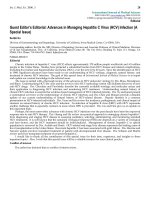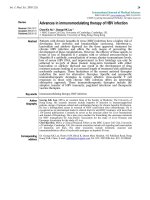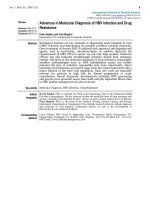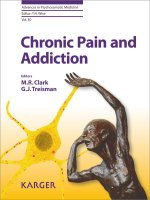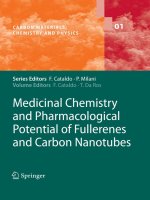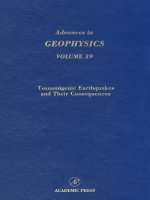Advances in medicinal chemistry
Bạn đang xem bản rút gọn của tài liệu. Xem và tải ngay bản đầy đủ của tài liệu tại đây (1.62 MB, 37 trang )
NONPEPTIDE INHIBITORS OF HIV
PROTEASE
Susan Hagen, J.V.N. Vara Prasad, and
Bradley D. Tait
I~
II.
III.
IV.
V.
VI.
VII.
Abstract . . . . . . . . . . . . . . . . . . . . . . . . . . . . . .
Introduction . . . . . . . . . . . . . . . . . . . . . . . . . . . .
F i n d i n g and Evaluating an Initial L e a d . . . . . . . . . . . . . .
Coumarins (4-Hydroxybenzopyran-2-ones)
...........
Pyrones (4-Hydroxypyran-2-one) .................
E l a b o r a t i o n of the 6 - A r y l - 4 - h y d r o x y p y r a n - 2 - o n e s . . . . . . . .
Tricyclic-4-hydroxypyran-2-ones ..................
5,6-Dihydropyrones . . . . . . . . . . . . . . . . . . . . . . . .
A. Cellular Activity . . . . . . . . . . . . . . . . . . . . . . .
B. Effect of Polarity on the Cellular Activity . . . . . . . . . .
C. 6 - A l k y l - 5 , 6 - D i h y d r o p y r a n - 2 - o n e s Filling the S~ P o c k e t . .
D. Achiral D i h y d r o p y r o n e s . . . . . .
.............
E. Synthesis of the D i h y d r o p y r o n e s . . . . . . . . . . . . . . .
E P h a r m a c o k i n e t i c (PK) Properties
..............
G. Profile of P D 178390 . . . . . . . . . . . . . . . . . . . . . .
Advances in Medicinal Chemistry
Volume 5, pages 159-195.
Copyright 9 2000 by JAI Press Inc'
All rights of reproduction in any form reserved.
ISBN: 0-7623-0593-2
159
160
160
161
162
163
164
171
172
178
180
184
185
187
189
189
160
VIII.
SUSAN HAGEN, J.V.N. VARA PRASAD, and BRADLEY D. TAIT
Conclusions . . . . . . . . . . . . . . . . . . . . . . . . . . . . .
Acknowledgments . . . . . . . . . . . . . . . . . . . . . . . . .
References . . . . . . . . . . . . . . . . . . . . . . . . . . . . . .
191
191
191
ABSTRACT
Mass screening of our compound collection, utilizing the Amersham SPA
technology, afforded pyrone and coumarin non-peptide templates as initial
lead structures. X-ray cocrystallization and structure-based design were
utilized to assist in the design of more potent inhibitors. These efforts
resulted in the design of the 5,6-dihydropyrones, which afforded a more
flexible template from which to fill the internal pockets of the enzyme.
Optimization of the dihydropyrone series afforded a potent antiviral agent,
PD 178390 (ECs0 = 0.20 I.tM, TD50 = >100 ~tM). PD 178390 retained
antiviral potency in the presence of serum proteins with a modest threeto fivefold drop in antiviral activity in the presence of 40% human serum.
The antiviral activity, in PBMCs, was unchanged against clinical strains
of resistant HIV virus. In addition, PD 178390 showed excellent bioavailability in mice, rats, and dogs as well as a low level of P450 inhibition in
microsomal assays. This combination of good antiviral efficacy, good
pharmacokinetics, and low P450 inhibition make PD 178390 a promising
agent for the treatment of HIV infection.
I.
INTRODUCTION
Since the identification of the human immunodeficiency virus (HIV) as
the causative agent of AIDS, the pharmaceutical and research communities have focused enormous energy and resources on the development of
anti-retroviral chemotherapies. The reason behind such intense focus is
obvious: it has been estimated that by the year 2000 more than 30 million
individuals will be infected with HIV. ~ Therefore, the search for new
targets for therapeutic intervention continues unabated as studies reveal
further details of the HIV life cycle. One target of particular interest is
H!V protease, an essential viral enzyme required for the cleavage of viral
polypeptides into functional enzymes. 2 Inhibition of the HIV- 1 protease
results in the production of virions that are incapable of maturation and
infection. Not only is the HIV protease essential to viral replication, but
it has been repeatedly isolated and crystallized as inhibitor-enzyme
complexes. 3 Such complexes have provided a wealth of information
invaluable in the design of highly potent, highly specific protease inhibi-
Nonpeptide Inhibitors of HIV Protease
161
tors. Indeed, the development and use of protease inhibitors has revolutionized AIDS care. 4
However, the success story of the protease inhibitors has been muted by
the emergence of several disturbing trends. Many of the currently marketed
inhibitors suffer from low bioavailability, substantial protein binding, and
short half-lives. 5 These attributes result in drugs that are expensive and
inconvenient to take. 6'~ in addition, significant side effects and drug interactions restrict the usefulness of these agents in real-world scenarios. 6'7 Most
ominous is the development of HIV strains that are resistant to almost all
current therapies. 8 Therefore, the need for novel protease inhibitors which
are not cross-resistant to the current generation of agents remains.
In many cases, the focus of new research has shifted to synthetic
non-peptidic molecules of low molecular weight. Towards this end, we
at Parke-Davis initiated a screening strategy to identify a nonpeptide hit
suitable for further optimization. The implementation of this strategy and
the optimization of the resulting lead are the focus of this review article.
II.
FINDING AND EVALUATING AN INITIAL LEAD
We screened our compound collection (consisting of approximately
150,000 chemical entities) with a high throughput SPA (Scintillation
Proximity Assay) developed by Amersham to find an initial lead for
further optimization. The assay was done in 96 well plates utilizing a
l]-scintillation counter to monitor the reaction. We initially screened the
compounds as solutions of 10 compounds at ~100 gM each. Any well
with greater than 50% inhibition was deconvoluted into a single compound per well at 50 gM, 30 gM, and 10 gM concentrations and assayed
using the SPA technology. Compounds that had an IC50 of less than 50
l.tM were then run in an HPLC assay. 9
After our analysis we ended up with about 15 series which were
clustered on the basis of their structures. ~~We prioritized the series based
upon the following criteria:
1. non-peptidic structures;
2. selectivity for HIV protease (leads should not be hits in multiple
mass screens);
3. purity and integrity of the sample;
4. reasonable modes of binding to HIV protease (hits were docked
into the protease active site); and
5. competitive inhibition (as estimated by kinetic analysis).
162
SUSAN HAGEN, J.V.N. VARA PRASAD, and BRADLEY D. TAIT
OH
PD 107067
IC5o = 3.1 I~M
PD:099560
ICso= 2.3 I~M
Figure 1. Initial mass screen hits.
Additional background information such as other biological activity,
toxicity, patent status, and physical properties was also obtained to better
understand what data was available on the series in question. Finally,
additional congeners were pulled from our compound collection and
tested in the HPLC assay to get an initial read on the structure-activity
relationships (SAR).
After a full analysis of the hits we focused on the coumarin (PD
099560 ICs0 = 2.3 gM) and pyrone (PD 107067, ICs0 = 3.1 gM) as viable
compounds for further elaboration (Figure 1). Both Parke-Davis 9-31 and
Pharmacia-Upjohn 3z-46have reported extensively on their work. We will
review our effort starting with the initial leads and optimization of the
leads into a potent biologically active compound, PD 178390.
Iii. COUMARINS (4-HYDROXYBENZOPYRAN-2-ONES)
Both Parke-Davis and Upjohn researchers have identified warfarin and
its analogue as weak inhibitors of HIV protease. 9'32Furthermore, Bourinbaiar et al. 47'48 have also reported that warfarin possessed an antiviral
effect on HIV replication and spread, but it was unclear if this antiviral
HOH
o
~OH ~
O
1 (Warfarin)
2
3
ICso = 30 I~M
IC5o= 1.9 I~M
I05o = 0.52 BM
Figure 2. Coumarin inhibitors.
~
Nonpeptide inhibitors of HIV Protease
Ileso
/
(
163
.llelso ~'~'~ $2'
-, : ' - . '
T
OH
o--';:' ":'-o
.u4 Asp12s
Asp2s
Figure 3. X-ray crystal structure of PD 099560 bound to HIV PR.
activity was due to inhibition of HIV-1 protease. Among the various
warfarin analogues tested Tummino et al. found that inhibitor 2 (Figure
2) was the most potent analogue.
At Parke-Davis, mass screening also identified another coumarin
analogue (PD 099560, Figure 1), as a competitive inhibitor of the
enzyme. 13'25 X-ray crystallographic structure of PD 0099560 bound to
HIV PR (Figure 3) revealed two binding modes. In both modes, the
4-hydroxycoumarin ring of the inhibitor displaced both water molecules
(the catalytic water as well as water-301) and the fused phenyl ring was
oriented in the S~ site. Active site interactions between the aspartates and
the 4-OH were similar to those observed in the pyrone X-ray. In one
binding mode, the flexible side chain extended to the S 3 region towards
Arg 108 while in the other mode, the side chain folded back down to the
S~ region. With this data in hand, several analogues were prepared to test
the binding interactions and improve the overall binding affinity. Among
them the best inhibitor 3 was found to possess an IC50 of 0.52 ~M (Figure
2). Unfortunately, extensive synthetic modification and substitution of
the coumarin ring system did not lead to significant increases in enzyme
potency for this series.
IV. PYRONES (4-HYDROXYPYRAN-2-ONE)
Though 4-hydroxypyran-2-one derivatives were first reported in 1993 as
anti-HIV agents 47,48 neither the mechanism of action nor the mode of
interactions with the protein was known until the recent reports from
Parke-Davis and Upjohn. Currently, various derivatives of the 4-hydroxypyran-2-one (e.g. 4-hydroxybenzopyran-2-ones (coumarins), sub-
164
SUSAN HAGEN, J.V.N. VARA PRASAD, and BRADLEY D. TAIT
Asp 2 5 / . 0 HO.~ /
r\
Asp 125
1T
o-.., . o
HO"
R_ .,J 4 - S ,
,,
7,,,
"H'
I
"H
I
N
N
lie 150 lie 50
Figure 4. Coumarin and pyrone core interactions.
stituted 4-hydroxypyran-2-ones, 4-hydroxycyclooctapyran-2-ones and
4-hydroxy-5,6-dihydropyran-2-ones)9-46have been reported to be potent
inhibitors of HIV protease. Both kinetic information and X-ray crystallographic data of these pyran-2-ones (Figure 4) reveal that these compounds act on HIV protease via a common mode of binding with the
enzyme in the active site. In particular, the 4-hydroxypyran-2-one replaces the water molecules found in the active site of the enzyme, while
the 4-hydroxyl group forms hydrogen bonds with the catalytic aspartates
(Asp25 and Asp 125). The lactone moiety forms hydrogen bonds with the
flaps lies (Ile50 and Ile150) by replacing water-301, a unique water
molecule found in all the X-ray crystallographic structures of peptidederived inhibitors binding to HIV protease. 3 It was theorized that various
groups could be appended to this pyrone core, groups that could interact
with the binding pockets of the protease enzyme. Such interactions
would thereby result in improvement in inhibitory activity against HIV
protease.
V. ELABORATION OF THE
6-ARY L-4- HY D RO XY PY RA N - 2 - O N ES
The 4-hydroxy-6-phenyl-3-(phenylthio)pyran-2-one (PD 107067, Figure 1) fulfilled all our initial criteria for a viable series suitable for further
elaboration. By chemical analogy with the known peptidomimetic hydroxyethylsulfide (HES), 48 PD 107067 was viewed as a conformationally restricted P1-P~ peptidomimetic (Figure 5). 14
Initially, modifications at the C-3 position were undertaken to explore
the optimal chain length at the S-Ph region. Extending the S-Ph moiety
to SCH2Ph and SCH2CH2Ph produced compounds 5 and 6, respectively
Nonpeptide Inhibitors of HIV Protease
165
Sl
$1
S~----~
S1'
Sl'
H
OH
....:::"
O"
d,
,"
AsP25
,,"o
~q,
go.
9 "'O
AsPt2s
Asp2s
Asp12s
Figure 5. Comparison of hydroxyethyl sulfide isostere with PD 107067.
(Figure 6), both of which displayed a two- to threefold enhancement in
enzyme activity. An X-ray crystal structure of 5 (see Figure 7) bound to
HIV protease showed a tight binding interaction between the SCH2Ph
group and the S~ pocket. As expected, the core interactions between the
pyrone nucleus and the active site remained unchanged.
Substitution of the phenyl group in the SCH2Ph moiety was evaluated,
in the hopes that the appropriate substituent might fill an additional
The S-Ph at
C-3"
4, n = 0 , X = H ,
5, n= 1 , X = H ,
ICso=3.11~M
ICso= 1.7 I~M
6, n = 2, X ---H, ICso= 1.3 I~M
7, n = 1, X = CO2(i.Propyl), ICso = 0.034 I~M
The Phenyl at
C-6"
OH
S
O
HO
ICso = 0.26 p,M
10
IC5o = 0.52 IJ.M
Figure 6. SAR of Pyrones.
IC5o = 0.49 p.M
166
S U S A NHAGEN, J.V.N. VARA PRASAD, and BRADLEY D. TAIT
Iles~
-NH" Ilelso
9 e
| t I
I,
-
,';
,
o..-"2:~
.,
.
AsP2s
$1'
" J
AsP12s
Figure 7. X-ray crystal structure of compound 5 bound to HIV PR.
binding pocket. Systematic modification of this phenyl group led to a
series of benzyl esters with increased enzymatic activity. 26 The most
potent derivative in this subclass, compound 7 contained an isopropyl
ester adjacent to the sulfur linkage and is shown bound to the protease
enzyme in Figure 8. Surprisingly, this X-ray crystal structure revealed a
change in binding mode" for compound 7 the SCH2Ph group is oriented
in the S~ pocket pocket while the COa(isopropyl)group fills the
S~ pocket. This observation differs decidedly from the X-ray crystal
structure for compound 5 discussed above, in which the unsubstituted
SCH2Ph group occupies the S~ pocket pocket.
Attention then shifted to the 6-position of the pyrone molecule.
Variation of the substituents on the phenyl ring at C-6 resulted in a series
of derivatives with improved enzyme activity. More specifically, the
Ileso-NH -
--NH" II~so
i~
S
I
\ ..",, /
0~.~0
.;:-~ ":,-..
O" ,"
Asp2s
%..?
3
"-o:
Mo
l
s,'
AsPI=s
Figure 8. X-ray crystal structure of compound 7 bound to HIV PR.
167
Nonpeptide Inhibitors of HIV Protease
meta-methyl analogue 8, the para-hydroxy analogue 9, and the 3,4benzodioxyl analogue 10 proved to be the most potent entities in this
class (see Figure 6). Apparently, a small hydrophobic group at the meta
position and a hydrophilic group para are well tolerated.
Therefore, appropriate substitution at C-3 and C-6 resulted in inhibitors binding to two (and sometimes 3) pockets of the protease enzyme,
and a concomitant increase in activity was observed. Occupation of
other binding pockets would conceivably lead to further significant
enhancements in potency. Toward this end, molecular modeling and
X-ray analysis suggested that branching at C-3 might achieve simultaneous binding at both S 1 and S2. For this reason, a series of (4-hydroxy6-phenyl-2-oxo-2H-pyran-3-yl)thiomethanes was synthesized and their
binding affinities were measured. 15 The results are summarized in Table 1.
Both S-aryl and S-aliphatic groups, having different steric and hydrophobic properties, were introduced to optimize the molecular recognition and the binding affinity. In the S-aryl series 11-18 (phenyl and
benzyl), the cylopropylmethyl group was the most effective substitution
at the R 2 position, whereas phenyl and benzyl groups were well
accommodated at the SR 1 position. Overall, the S-aliphatic series,
(19-25, Table 2) showed better binding affinity relative to the S-aryl
t
t
Table 1. 4-Hydroxypyran-2-ones Having S-Aryl Functionalization at
C-3
OH S" R1
Compound
11
12
13
14
15
16
17
18
R1
Ph
Ph
Ph
Ph
Ph
Benzyl
Benzyl
Benzyl
R2
H
Ph
cyclohexyl
i sobutyl
isopentyl
Ph
isobutyl
CH2cPr
IC50 (I~M)
84.3
O.78
2.44
0.41
0.39
0.48
0.26
0.084
168
SUSAN HAGEN, J.V.N. VARA PRASAD, and BRADLEY D. TAIT
Table 2. 4-Hydroxypyran-2-ones Having S-Aliphatic Functionalization
at C-3
OH S"R1
Compound
19
20
21
22
23
24
25
R1
R2
Cyclohexyl
Cyclohexyl
Cyclohexyl
Cyclohexyl
Cyclopentyl
Cyplopentyl
Cyclopentyl
Ph
isobutyl
CH2cPr
neopentyl
cyclopentyl
isobutyl
CH2cPr
IC50 (~tM)
0.48
0.32
0.15
0.30
0.22
0.058
0.069
OH S~
series. Unlike the S-aryl series, both branched and cyclic aliphatic
substituents impart potency at the R 2 position. Replacement of the
6-phenyl group with a 6-(benzodioxyl) group (26) resulted in a similar
or slight improvement in binding affinity. Kinetic analysis of inhibitors 24 and 26 showed that they are competitive inhibitors with Ki
values 33 and 27 nM, respectively.
The X-ray crystal structure of 24 bound to HIV-1 PR (Figure 9)
showed a unique mode of binding which was not observed previously
with other inhibitors. In this case, the lactone carbonyl of the pyran2-one ring formed a direct hydrogen bond with NH of Ile50 only. This
result contrasts to the X-ray crystal structure of structurally related
inhibitor 5 (Figure 7), in which the lactone is positioned more symmetrically to form hydrogen bonds with both Ile50 and Ile150. The
enol moiety of 24 forms hydrogen bonds with Asp125 and interacts
indirectly with Asp25 via a bridging water molecule. This bridging
water has not been observed in any of the HIV PR crystal structures
169
Nonpeptide Inhibitors of HIV Protease
Iles~
- - N " Ilelso
H
~| l
I
~--~
9
,,,
~
~,,,~,/O,v~O
s
0 ~
d'" oo S
)~o:
Me NS 2'
9
"'O-H.
,"
~
AsPI2s
"-.
-..
"O
HOWl,
AsP25
Figure 9. X-ray crystal structure of compound 24 bound to HIV PR.
reported to date. The water molecule is 3.4 ~ away from the sulfur
atom present in the inhibitor. The S-cyclopentyl and isobutyl occupy
the S~ and S 2 pockets, respectively, whereas the 6-phenyl group' straddles the S 1 and S 3 pockets of the enzyme.
The strategies used to fill the S~ and S~ pockets involved branching
at C-3 position and therefore resulted in the formation of a new chiral
center. Our efforts to eliminate chirality and simultaneously improve
binding affinity resulted in an interesting series of pyran-2-one analogues shown in Table 3. 20 This strategy (Figure 10) evolved from a
literature report that c~-alkylbenzamides can be incorporated into HIV
PR inhibitors as P~ proline mimics. 51 Adapting this idea to our pyran2-one series and replacing the amide portion with simple alkyl re/
/
Ileso.~,H_~
P1
.
o
2,s
P2'
-NH"Iielso
o.
M,H'"
O.
e
~p,
,%
Figure 10. Design of 3-S-[(2-Alkylphenyl)sulfanyl]-4-hydroxy-6-pyran-2ones.
170
SUSAN HAGEN, J.V.N. VARA PRASAD, and BRADLEY D. TAIT
Table 3. 4-Hydroxypyran-2-ones: Substitution on the 3-SPh Ring
OH
Compound
R
R
ICso (I~M)
27
28
29
30
31
H
Me
Et
n-propyl
isopropyl
3.0
0.42
0.17
0.090
0.037
32
33
34
sec-butyl
tea-butyl
CH2cyclopropyl
0.10
0.017
0.10
suited in a 3-S-(2-alkylphenyl)group as the P~/P~ ligand (Figure 10).
Optimization of the size of the alkyl group lead to an inhibitor, 33,
possessing a Ki of 3 nM (Table 3).
The X-ray crystal structure of 31 bound to HIV-1 PR revealed the
typical hydrogen-bonding interactions of central pyran-2-one ring as
described previously. In contrast to our initial hypothesis, but in line
with the molecular modeling prediction, the isopropyl group present
on the 3-S-phenyl group occupied the S~ pocket, whereas the 3-Sphenyl group partially filled the S~ pocket (Figure 11). This analogue
occupies only three pockets of the enzyme, yet possesses very high
Iles~
-NH" Ilelso
s,c :,4
,,,,
:"
,,,,
.'.'
$2'
0
OH
."
~J.-OH
Asp2s
,"
Me ----,Ma
'
-O
Sl'
AsP12s
Figure 11. X-ray crystal structure of compound 31 bound to HIV PR.
i
Nonpeptide Inhibitors of HIV Protease
171
Table 4. 4-Hydroxypyran-2-one: Tethers on the para Position of the
6-Phenyl
OH
OH
R
OCH2COOH
OCH2Ph
OCH2(3-pyridine)
Compound
35
37
39
ICso(IzM)
0.16
0.33
1.5
Me.
Me
Compound
36
38
40
IC5o(lzM)
0.019
0.28
0.045
binding affinity to HIV PR. To further optimize activity, a Topliss
operationalscheme 5~ was used for substitution on the phenyl ring the
6-position, with modest results. 23
Since the S 1 and S 3 pockets are topographically contiguous, it was
envisioned that a group appended to the C-6 phenyl group (which
occupies the S 1pocket) could reach into the S 3 pocket via a judiciously
chosen tether. In general, the tethering approach 51 might fill either the
S 3 pocket or protrude through the active site openings to the solvent;
these tethers could also be useful in altering the physical properties
of the inhibitor. 52 Thus pyran-2-one analogues with various tethers at
the para and meta positions of the 6-phenyl ring were prepared in both
the 3-SCH2CH2Ph series and 3-SPh(2-iPr) series, 27'28 The results are
described in Table 4. Initially a tether containing OCH2COOH at the
para position of the 6-phenyl ring was designed to interact with Arg-8
present in the S 3 pocket of the enzyme. The inhibitors 35 and 36,
obtained from 3-SCH2CH2Ph series and 3-SPh(2-iPr) series, respectively, showed a five- and twofold enhancement in binding affinities
compared to the parent compounds. Since aromatic hydrophobic
groups are known to occupy S 3 pocket of the enzyme, various hydrophobic groups were also u s e d . 53 It was found that a tether from the para
position was optimal for binding to HIV PR (Table 4).
VI. TRICYC LIC-4-HYDROXYPYRAN-2-ON ES
The tricyclic 4-hydroxypyran-2-ones (Figure 12) were synthesized as an
intermediate structure between the coumarins and 6-aryl-4-hy-
172
SUSAN HAGEN, J.V.N. VARA PRASAD, and BRADLEY D. TAIT
o,-,
o,-,
0
HO
0
41, IC5o = 1 IJ.M
Figure 12. Tricyclic 4-hydroxypyran-2-ones.
droxypyran-2-ones. The analogues containing SCH2Ph or SCH2CH2Ph
moiety at the 3-position did not show improved binding affinity when
compared to 6-aryl-pyran-2-one series. The best compound in the series,
41, possesses an IC50 of 1 ~M against HIV PR.
VII. 5,6-DIHYDROPYRONES
The coumarin and pyrone ring systems are rigid and planar and thus
groups attached to the ring systems are locked into position relative to
each other and relative to the core binding interactions. We hypothesized
that the 5,6-dihydropyrones 1~176
would offer a more flexible template that would allow the substituents to make modest conformational
adjustments without interfering with the core binding.
Molecular modeling of the dihydropyrone template was carried out
using the Sybyl software program and a preliminary X-ray structure of
HIV protease from the PD 099560 complex. Due to the structural
similarities among the 4-hydroxybenzopyran-2-one, the pyrone, and the
dihydropyrone templates, we believed that a similar core-binding mode
would occur in all the templates. We therefore turned our attention to
exploring ways of filling the S 2 and S 1 pockets. Our model of the
6-phenylpyrones such as PD 107067 (Figure 1) indicated that the
6-position substituent filled S 1. It was apparent from analysis of a
coumarin X-ray and the subsequent dihydropyrone model that S 2 could
be reached from the sp 3 carbon atom at the 6-position of the dihydropyrone by appending an appropriate substituent (R in Figure 13).
Inhibitor 47b (Table 5) was modeled in the active site with the S
configuration. The phenyl ring was placed in the equatorial position and
bound in S~ and the isopentyl group was in the axial orientation and
extended to S z (Figure 14). Figure 14 shows a model of 47b overlaid with
the Abbott HIV protease inhibitor (A-74704). The Abbott structure
173
Nonpeptide Inhibitors of HIV Protease
~
P2
PI' (or P2')
0
n
P1
R=H
n=l
ICso=8,900nM
R=H
n=2
ICso=2,100nM
Figure 13. 4-Hydroxy-5,6-dihydropyrones: P1-P~ (or P2)"
Table 5. Hydrophobic Groups Designed to Fill $2: P2P1-P~ (or P2)
~9
1Go(nM)
Compoun@
41a,b
42a, b
43a,b
44a, b
45a, b
46a, b
47a, b
48a, b
49a,b
50a
51a,b
52a,b
R
H
(CH2)2Me
(CH2)3Me
(CH2)4Me
(CH2)sMe
CH2CHMe 2
(CH2)2CHMe2
(CH2)3CHMe2
CH2-cPentyl
CH2-cHexyl
Ph
(CH2)2Ph
Note:. aWherea is n = 1 and b is n = 2.
a
b
n=l
n=2
8,900
290
27O
124
180
44O
98
183
88
137
262
60
2,100
5100
400
84
112
1,200
96
155
510
152
51
174
S U S A NHAGEN, J.V.N. VARA PRASAD, and BRADLEY D. TAIT
Figure 14. Model of 47b overlayed with A-74704.
Figure 15. X-ray of 44b overlayed with A-74704.
Nonpeptide Inhibitors of HIV Protease
175
assists in the visualization of the approximate position of P1 and P2 but
does not define the surface area of the pockets. Our model indicated that
from the 6-position we needed a 2-atom spacer followed by the substituent to fill S 2. The model also predicted that a phenyl at the 6-position
was a reasonable substituent to fill S 1. Therefore, we held the phenyl
constant and varied the R group to reach for S 2 (Table 5).
Our initial analysis led to the preparation of straight-chain alkyl
groups at C-6 (see Table 5, 42-45). Due to their flexibility, these
straight-chain alkyl groups could readily adjust to the surface of the
enzyme to maximize hydrophobic interactions, albeit with an entropic
price. In any event, the potency increased as the chain was lengthened
from hydrogen (ICs0 - 2100 nM, 41b) to n-pentyl (ICs0 = 84 nM, 44b).
Branched alkyl groups designed to mimic the P2 and P2 hydrophobic
amino acids, valine and leucine (46-48, Table 5) were then investigated.
Modeling predicted that isopentyl (47) and isohexyl (48) substituents
would most closely mimic valine and leucine, respectively. These
branched derivatives showed an increase in potency over the unsubstituted parent (ICs0 = 2100 nM, 41b) with the most potent compound being
the isopentyl substituent (ICs0 - 96 nM, 47b), the valine mimic.
Workers at Merck have reported that phenyl glycine is an effective
P2 replacement for valine in peptidic HIV protease inhibitors. In a logical
extension of their work, we prepared the phenethyl derivatives (52) as
phenyl glycine mimics. Compound 52b showed excellent activity versus
the enzyme with an ICs0 of 51 nM.
Our model indicated, and the activity confirmed, that the isobutyl
group (46) was not reaching far enough to fill S 2. To more effectively fill
the S 2 pocket, the two methyls of the isobutyl group were expanded and
cyclized into five-membered ring (49) and six-membered ring (50a). In
fact, compounds 49a and 50a were better than compound 46a by more
than threefold, thus suggesting enhanced interactions with the enzyme.
An X-ray cocrystal structure of racemic 44b bound into HIV-1 protease was obtained (Figure 15). The general core interactions were
consistent with those found in the coumarin X-ray and the dihydropyrone
model. The presence of electron density in both S~ a n d s 2 indicates a
mixed population for the thiophenethyl group between the two pockets.
It was hoped that only the more potent enantiomer would be bound in
the active site but the X-ray indicated that both enantiomers of 44b were
present. Therefore, an accurate determination of the preference for the
phenyl and n-pentyl groups to reside in S 1 or S 2 could not be obtained
from the electron density. What is clear is that the substituents (phenyl
and n-pentyl) fill both S 2 and S~, thus increasing the potency of these
176
SUSAN HAGEN, J.V.N. VARA PRASAD, and BRADLEY D. TAIT
262 nM range (51), although not as potent as the racemic 6-phenyl-6-npentyl parent (44).
We next turned our attention to filling S 2 with side chains that mimic
the more polar amino acids~asparagine, glutamine, and glutamic acid
(Table 6). Asparagine has been used at S 2 in peptidic inhibitors such
as Ro-31,8959 with excellent success. Modeling suggested that the
optimal side chains should be -(CH2)3-CONH 2, -(CH2)4-CONH 2, and
-(CH2)a-COOH, respectively. The most potent compound was carboxylic acid 55 with an IC50 of 5 nM. The potency decreased by almost 2
orders of magnitude when the carboxylic acid (55) was replaced with a
primary amide (57).
Work in the pyrone series delineated the beneficial effect of substituting ortho to the sulfur linkage on the S-phenyl with an isopropyl moiety.
Modeling of the ortho isopropyl functional group with the 5,6-dihyropyrone template indicated that it probably filled the S~ pocket This observation led to modifications of the initial dihydropyrone lead, resulting in
agents with improved enzyme potency (Table 7).
To address the question of steric requirements of S~ (Table 7) a number
of derivatives containing ortho-alkyl groups were prepared. Reducing the
isopropyl group (60) to a methyl decreased the activity by 5- to 10-fold
(59); increasing the size to sec-butyl (61) or cyclohexyl (62) instead of
isopropyl (60) provided equally potent compounds. Relative to isopropyl, a tert-butyl moiety engendered a four- to fivefold increase in activity
(IC5o of 3 nM, 63).
Table 6. Polar Groups Designed to Fill S2" P2P1-P~ (or P2)
Compound
53
54
55
56
57
R
tQo (riM)
(CH2)2CO2H
(CH2)3CO2H
(CH2)4CO2H
1,200
270
5
(CH2)3CONH2
(CH2)4CONH2
1,300
338
Nonpeptide Inhibitors of HIV Protease
177
Table 7. Optimization of P~P2 Substituent: P2P1-P~P2
H
Compound
R'
8'
R"
IC5o (nM)
58
59
60
61
62
H
Me
CHMe2
CHMeEt
cHexyl
H
H
H
H
H
63
64
65
CMe3
CHMe2
CHMe2
H
Me
CHMe2
3
7
14
66
67
68(S)
69(R)
CMe 3
Me
CHMe2
Me
Me
10
47
6
130
CMe3
CHMe2
CHMe2
130
73
14
10
32
Assuming that the ortho substituent effectively satisfied S~, attention
turned to more optimally filling the S~ pocket from the appropriate
position of the phenyl ring (64-67). To determine that optimal substitution, a series of analogues was synthesized in which the ortho substituent
was held constant as an isopropyl or tert-butyl group while varying the
position para to the alkyl moiety. The methyl isomers display an enhancement in potency (64). The size of the methyl group appeared to be
somewhat optimal, since the corresponding isopropyl compounds (65,
67) all displayed a loss in activity versus the methyl derivatives (64, 66).
In general, the inhibitory activity data indicates that a 2-tert-butyl/2isopropyl group and 5-methyl moiety on the phenyl ring effectively fill
the S~ and S~ pockets, respectively. To verify this model, an X-ray
crystallographic study of racemic 64 with the protein was undertaken;
unfortunately, from the electron density it was not possible to determine
either the preferred enantiomer for binding or whether both enantiomers
are bound. To overcome this problem, the (R)- and (S)-enantiomers were
prepared and tested (68, 69); the (S)-enantiomer (68) proved to be 20-fold
more potent the corresponding (R)-enantiomer (69).
The X-ray crystallographic structure of 68 complexed with the HIV
protease enzyme was obtained (Figure 16). As expected the interactions
178
S U S A NHAGEN, J.V.N. VARA PRASAD, and BRADLEY D. TAIT
ASP1=5
Asp2s.~QH
O,'
$2(/~
0/-77/
,,' ,.O
"'""""'H'O"'"'Me
"" v,~
~ ' ' Me,
e
i
$1
Ile15oHl~
i
|
",
S2'
i
NHIle5o
Figure 16. X-ray of compound 68.
between the dihydropyrone ring and the protease active site were consistent with the previous X-rays. Also as predicted, the 3-position substituent occupies the S~ site via the isopropyl group and the S~ site site
via the 5-methyl substituent. The (S)-enantiomer binds the phenyl group
in the S 1 site and orients the phenethyl chain in the S 2 pocket. The
(S)-enantiomer, predicted to be the more potent inhibitor, displays a
binding affinity of 6 nM, whereas the (R)-enantiomer has an IC50 = 130
nM. This is in contrast to reports by Upjohn where the 6-phenethyl
occupies S1/S3 and a 6-n-propyl occupies S 2. Although the Upjohn and
Parke-Davis groups were both working on the dihydropyrone template,
the preferred chirality of the substituents at the 6-position is apparently
reversed.
A. Cellular Activity
In spite of obtaining a 1000 fold improvement in IC50, the best
compounds did not show a significant therapeutic index (TDs0/ECs0 of
> 10-fold) in cellular assays and therefore did not warrant claims of
antiviral activity. The lack of cellular activity despite ICs0's in the 3-10
nM range necessitated a close examination of possible explanations.
One area of concern was the pKa of the 4-hydroxyl group (pKa =
4.5-6.5) which is more acidic than a normal alcohol. We believe the
protonated form of the dihydropyrone is the bound form of the inhibitor
in the active site, and therefore, ionization decreases the quantity of the
active protonated form. Thus, the pH of the assay would be expected to
have an effect on inhibitory activity. To test this theory we took the best
Nonpeptide Inhibitors of HIV Protease
179
compounds and ran the assay at a pH of 6.2 rather than at a pH of 4.7.
We found the dihydropyrones did lose potency at the higher pH (Table
8). Although all the compounds decreased in activity, the 2-tert-butyl-5methyl compound (66) retained more of its inhibitory efficacy than did
the other dihydropyrone derivatives. Therefore we utilized the more
stringent pH of 6.2 for further SAR development. In Tables 1-7 the ICs0's
were run at a pH of 4.7 whereas in Tables 9-15 the ICs0's were run at a
pH of 6.2.
Stability and protein binding were other issues of concern. After
incubating the dihydropyrones in cell culture for 7 days, we were able to
recover greater than 90% of the unchanged parent. Obviously, then, the
integrity of the sample was not an issue. However, the possibility that the
dihydropyrone nucleus would be strongly bound to serum proteins
proved more serious. The pharmacokinetic literature indicated that the
coumarin template binds very effectively to albumin (Site 1).54 Our data
indicated that the activity of the dihydropyrones in vitro decreased in the
presence of albumin. Increasing the polarity of the compounds or raising
the pKa of the 4-hydroxyl should decrease protein binding.
Other conceivable explanations for the lack of cellular activity concerned cellular penetration and active effiux. Our data in the Caco-2
penetration model indicated the compounds should have significant
cellular penetration. Although the data from our active efflux studies
were not conclusive this also did not appear to be a problem with the
compounds as a class.
Table 8. Effect of Assay pH on IC5o'Sa
OH
Ph' -o- -o T
Compound
60
64
63
66
Note:
R'
CHMe 2
CHMe 2
CMe 3
CMe 3
alCs0'sreported in nM.
R"
H
Me
H
Me
R'
a"
ICso at pH 4.7
14
7
3
10
ICso at pH 6.2
97
79
104
35
180
SUSAN HAGEN, J.V.N. VARA PRASAD, and BRADLEY D. TAIT
B. Effect of Polarity on the Cellular Activity
Initial attempts to improve cellular potency centered on the addition
of polar functional groups to the dihydropyrone parent. Compound 66
was chosen as the parent structure for these preliminary studies. Examination of the X-ray crystallographic structure of analogue 68 bound to
the protease enzyme indicated that several possible sites existed for such
synthetic modification. It was hoped that these substitutions could modulate physical properties as well as pick up additional interactions with
the protein. With these caveats in mind, several sites for potential
modification were identified: the 4' position of the aryl ring at C-3, the
3' or 4' position in the phenethyl ring at C-6, or the 4' position of the
phenyl ring at C-6.
The effect of adding a single polar group to the phenethyl moiety at
C-6 is summarized in Table 9. In almost all cases, the polar analogues
were at least equipotent to the parent compound in the HIV protease
assay; the exceptions to this trend were those derivatives containing
either a NHAc group (74) or two methoxy groups (76). Unfortunately,
cellular potency for these polar derivatives remained virtually unchanged
from the parent---in only one case (70, where X = 3-OH) was any hint
of cellular activity observed. A similar result was seen when the polar
Table 9. Polar Groups at C-6 Phenethyl
X"~
OH
$
0
Compound
7O
71
72
73
74
75
76
77
78
66
X
3-OH
4-CONH 2
4-NH2
4-OH
4-NHAc
3-NH 2
3,4-diOCH 3
3,4-diOH
2-OH
H
IC5o (nM)
16
271
24
11
507
17
405
24
80
35
ECso(~tM)
13
x
>54
>69
x
>65
x
>66
>31
>55
TCso (~tM)
57
x
54
69
x
65
x
66
>31
55
Nonpeptide Inhibitors of HIV Protease
181
group was added to the phenyl group at C-6 (Table 10): that is, most
analogues retained the desired enzymatic activity but displayed no
increased antiviral efficacy, Clearly, though, the flexibility of the dihydropyrone skeleton afforded ample opportunity for substitution and
elaboration.
More promising results arose from substitution on the aryl ring at C-3
(Table 11). A variety of substituents were appended to the 4' position of
the S-aryl ring. As noted previously, these polar analogues at least
retained the enzyme potency of the parent compound. Furthermore, in
four cases~compound 89 (where Z = CH2OH ), compound 88 (where
Z - OCH2CH2OH ), compound 91 (where Z = OCH2CONH2), and 93
(where Z = HNAc)~the activity of the polar analogue actually increased
three- to fourfold over that of the parent. Unfortunately, this boost in in
vitro potency correlated with an increase in cellular potency for 89 only
(ECs0- 2.5 gM). For the first time, though, a single polar group conferred
an increase in both enzymatic and cellular activity.
The beneficial effects of the CH2OH moiety warranted further exploration in a series of disubstituted analogues. Introduction of polar functionalities at C-3 and at C-6 resulted in derivatives 95-102 (Table 12).
For compounds 95 through 98, a hydroxyl or amino group was substituted at various positions in the phenethyl ring while the CHEOH group
was kept constant at C-3. All compounds in this series displayed a
..
Table 10. Polar Groups at C-6 Phenyl
H
u
Compound
79
80
81
82
83
84
66
Y
OCH 3
OCH2CH2OH
OCH2Ph
OH
NHAc
NH 2
H
IC50(nM)
62
12
>196
40
10
32
35
ECso(gM)
TCso(gM)
>27
9.4
>30
>23
>66
>67
>55
27
23
30
23
66
67
55
182
SUSAN HAGEN, J.V.N. VARA PRASAD, and BRADLEY D. TAIT
Table 11. Polar Groups at C-3 S-Phenyi
OH
Compound
85
86
87
88
89
90
91
92
93
94
66
/Qo (nM)
z
OCH 3
OCH2CO2CH 3
OH
OCH2CH2OH
CH2OH
O(CH2)3OH
OCH2CONH 2
OCH2CONHEt
NHAc
NH 2
H
EGo (~M)
15
20
33
7
7
18
8
38
7
11
35
TQo (~M)
>33
>31
>23
>20
2.5
>25
>21
>64
21
>64
>55
33
31
23
20
66
25
21
64
69
64
55
Table 12. Polar Groups at C-6 and C-3
0
Z
CH3
Y
Compou
nd
95
96
97
98
99
100
101
102
66
4-OH
3-OH
4-NH 2
3-NH 2
H
H
H
4-OH
H
Z
H
H
H
H
OCH2CH2OH
OCH2CH2OH
OCH2CH2OH
OCH 3
H
CH2OH
CH2OH
CH2OH
CH2OH
CH2OH
OCH2CH2OH
OH
CH2OH
H
/C5o
(riM)
1.7
2.5
3.1
4.0
1.4
6.4
3.7
x
35
EC5o
(pM)
4.7
6.1
3.7
3.1
4.2
1.8
4.2
2.0
>55
TCso
(~M)
>100
> 100
94
23
67
25
27
>100
55
Nonpeptide Inhibitors of HIV Protease
183
dramatic enhancement in enzyme activity; more impressive, however,
was the concomitant improvement noted in cellular activity. Every
compound in this series possessed low micromolar efficacy in the cellular
assay, and in most cases this efficacy was clearly separable from cellular
toxicity. For the first time, then, a series of dihydropyrones demonstrated
potency in both the enzymatic and cellular assays, producing compounds
with therapeutic indices in excess of 20.
For the sake of completeness, a small series of analogues (Table 12,
entries 99-101) was prepared in which a polar group was held constant
in the phenyl ring at C-6 while a number of substituents was introduced
into the C-3 aryl ring. In this case, the polar group at C-6 was chosen to
be OCH2CH2OH , a moiety which was previously shown to confer good
enzyme activity, albeit without antiviral potency. As before, the enzyme
activity of these analogues improved 5- to 25-fold when compared to the
parent while the cellular activity reached into the low micromolar range.
However, these derivatives also displayed increased toxicity in the cellular assay, especially when compared to analogues in Table 11. It is
interesting to note that the addition of the CH2OH group at C-3 conferred
the greatest boost in activity for this disubstituted series, just as it did in
the monosubstituted series.
Therefore, addition of the appropriate polar groups to the dihydropyrone framework resulted in marked improvement in both enzymatic and
cellular activities. As anticipated, the flexibility of the dihydropyrone
skeleton afforded ample opportunity for such modification. In particular,
a hydroxyl or amino group on the phenethyl ring at C-6 and a CHzOH
moiety at C-3 seemed to confer antiviral activity without cellular toxicity.
At this point, another strategy was devised so that lipophilicity and
polarity could be modified without introducing further polar substitution:
namely, the phenyl group at C-6 was replaced with various alkyl substituents. Molecular modeling suggested that the pocket at S 1 would easily
accommodate the various conformations of different alkyl and cycloalkyl
groups.
A series of 6-alkyl derivatives was prepared as summarized in Table
13. In the first series (103-106), the phenethyl group was substituted
with a 4-OH group and the C-3 aryl moiety contained the benzyl alcohol
substituent while the C-6 group was varied. When the aryl group was
replaced with the isosteric cyclohexyl moiety (103), no significant
change in enzyme activity was noted. However, the cellular antiviral
potency increased dramatically when compared to the C-6 phenyl analogue (95)---a ninefold increase in efficacy. Similar results were obtained
